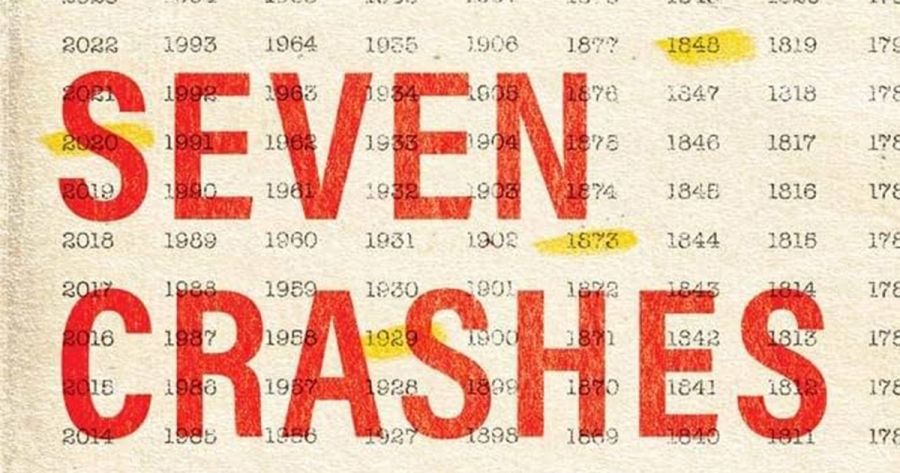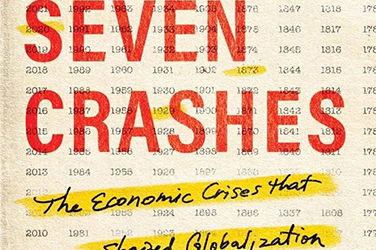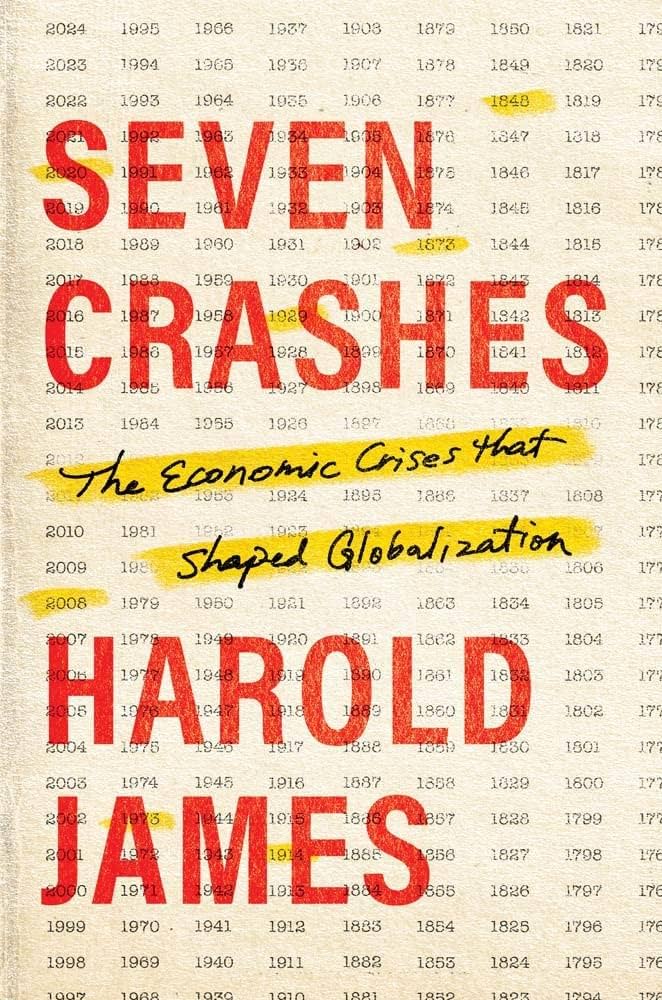
- Free Article: No
- Contents Category: Economics
- Review Article: Yes
- Article Title: Turnip winters
- Article Subtitle: A three-in-one on financial disruption
- Online Only: No
- Custom Highlight Text:
This fascinating and frustrating volume is really three books in one: a compilation of revelatory portraits of seven modern economic crises; a beautiful essay on language, literature, and finance; and an effort to draw lessons from the seven calamities. Of the three books, two are brilliant, one less so.
- Featured Image (400px * 250px):

- Alt Tag (Featured Image): Stuart Kells reviews 'Seven Crashes: The economic crises that shaped globalisation' by Harold James
- Book 1 Title: Seven Crashes
- Book 1 Subtitle: The economic crises that shaped globalisation
- Book 1 Biblio: Yale University Press, US$32.50 hb, 374 pp
- Book 1 Cover Small (400 x 600):

- Book 1 Cover (800 x 1200):

His examination of the first months of the Covid pandemic is also compelling. A Milan football match in February 2020 produced a surge of cases, as did other large gatherings, such as Brescia’s folk festival of San Faustino. A barkeeper in an Austrian ski resort showed symptoms; authorities closed the bar and then the whole resort, sending tourists home and sparking outbreaks in forty-five countries.
The Covid-era stock market slump was short-lived: from 20 March 2020, the market surged as money poured into technology stocks as well as crypto junk like the prankish ‘Dogecoin’. James points out that the Covid market mania mirrored a central feature of nineteenth-century market bubbles: ‘Hedge funds drove two rival Canadian railroad companies … into a bidding war for Kansas City Southern.’
In the second book nested inside Seven Crashes, James points out that ‘crash’ is the Anglicised form of Krach, which, after the 1873 financial crisis, became the standard way of describing financial disruption. (In 1929, President Herbert Hoover used the word ‘depression’ because it sounded milder than ‘crash’ or ‘panic’. But the word chosen to connote a little dip or gully soon sounded much worse than that.)
After the 1873 crisis, English novelist Anthony Trollope published The Way We Live Now, an indictment of ‘universal financial and speculative frenzy’. James searches for the real-life model for Trollope’s railway anti-hero Augustus Melmotte: possibly the ‘railway king’ George Hudson, Conservative German MP Bethel Strousberg, or Conservative British MP and disgraced banker John Sadleir, who, like the fictional Melmotte, poisoned himself with prussic acid. James studies clouds, storms, waves and thunderbolts as financial metaphors. Friedrich Spielhagen’s novel Sturmflut (1877) was about a plan to construct a railway line and harbour on an island in the Baltic. At the novel’s climax, fraudulent financier Philipp Schmidt is unmasked before a flood strikes the island, washing away a corrupt aristocrat. The same metaphors appear in Martin Scorsese’s The Wolf of Wall Street (2013), in which the wolf’s yacht capsizes in a Mediterranean storm.
In an instance of life imitating art, the October 1987 stock market crash followed an ‘exceptionally violent extratropical cyclone ... The fallen trees still prevented some traders from getting to work on the morning of Black Monday.’ Joseph Stiglitz’s 2006 critique of the 1990s Asian financial crisis depicted developing countries as leaky boats sent forth by the IMF ‘into the most tempestuous parts of the sea … without life-vests’.
Other metaphors came from the natural sciences, linguistics, libraries and the law. Prussian economist Hermann Heinrich Gossen believed his book The Development of the Laws of Human Relations (1854) ‘would make him a new Copernicus, but he died of tuberculosis, broken, demoralised and unknown’. Eventually, Stanley Jevons, who James thinks ‘should be counted as the principal creator of modern economics’, would cite Gossen as a forerunner, thanks to a chance find, by his colleague Robert Adamson, of Gossen’s book in a second-hand bookshop.
We learn that Jevons’s maternal grandfather was a poet and the author of a Life of Lorenzo de’Medici. James explains how Jevons helped give economics its modern name. ‘Political economy’ was misleading and redundant, Jevons argued, and while other authors had tried to introduce names such as ‘Plutology’, none of those was better than the convenient, single-word term ‘economics’, which was phonologically analogous to the Aristotelean fields of mathematics and aesthetics.
British economist John Maynard Keynes was a member of the Bloomsbury group of authors and artists. On 8 July 1919, after the Versailles Treaty was published, Virginia Woolf, another member, wrote in her diary that Keynes felt a disillusionment ‘forced on him by the dismal and degrading spectacle of the Peace Conference, where men played shamelessly … for their own return to Parliament’. Appalled by the spectacle, Keynes wrote The Economic Consequences of the Peace (1919), which thrust him into public prominence.
James’s literary survey also takes in Shakespeare, George Bernard Shaw, Alfred Tennyson, and Thomas Mann’s Buddenbrooks (1901) and Königliche Hoheit (1909), whose hero marries an American heiress (her father is modelled on Andrew Carnegie) causing interest rates to fall and sparking an era of prosperity.
Only with the third book inside Seven Crashes – an effort to draw seven general lessons from the seven calamities – does James stumble. Of the lessons, four (on the impact of negative demand and supply shocks) are almost tautologies and trivial; and one is essentially a restatement of the familiar Keynes quote: ‘Practical men who believe themselves to be quite exempt from any intellectual influence, are usually the slaves of some defunct economist.’
The sixth of the seven lessons – a macroeconomic restatement of the rational expectations hypothesis – contradicts James’s pattern-finding endeavour. ‘The turning points of globalisation,’ James writes, ‘do not resemble each other. Each moment of crisis challenges individuals, businesses, and governments in new and unprecedented ways.’ Finally, the seventh lesson is a big claim that James has not proven: ‘Negative demand shocks push in the direction of national self-sufficiency or even autarky.’
James does not have a good handle on money or inflation. He accepts the common idea that banks mediate between borrowers and lenders (they don’t) and that governments need to borrow in order to spend (they needn’t). James echoes Ben Bernanke in characterising inflation as an instrument of monetary policy. (In 2002, Bernanke earned the nickname ‘Helicopter Ben’ by suggesting governments could always create inflation by dropping cash from the sky.) But governments and central banks do not have full control over inflation, due to the role of private banks in money creation, and due to the role of other economic actors in causing and embedding inflation.
James’s characterisation of how shortages can lead to inflation through government action is neither compelling nor complete. He claims: ‘Governments often respond [to negative supply shocks] by allowing an inflation which they hope will allow their citizens to think that they may obtain more resources.’ That might be true sometimes, but it is often not the case. As with much of ‘book three’, the claim mixes orthodox macroeconomics with popular sociology and political science.
‘The 1840s provided the initial spur to modern globalisation,’ writes James. Historians of India would disagree – there was trade in pepper between ancient India and ancient Egypt – as would historians of China, Indonesia, the Virginia settlement, the Caribbean, and many other places.
The forces behind globalisation are complex and diverse. Looking for causes in crises ignores other important influences including technology, geopolitics, corporate strategy, management consulting (which has pushed outsourcing to low-wage, low-tax business locations), and legal causes such as the creation of the joint stock company. The crises themselves had different causes and took place in quite different economic and regulatory circumstances. Financial markets in general have an erratic relationship with the real economy. Not all economic shocks are accompanied by a crash.
‘In these dramatic shocks,’ James claims, ‘every expectation about normalcy … is stood on its head.’ That’s not true of the GFC or the Covid crisis, in which many economic relationships were stretched but did not break. Not all big historical shocks ‘caused profound political trauma’; and it is not true that during shocks, ‘only wild, utopian solutions look as if they stand any chance of success’; or that financiers ‘come into their own’. Sometimes they do, sometimes they don’t.
A better approach would be to analyse fundamental causes, several of which emerge from James’s survey. Paradoxically, the stable-seeming gold standard caused and exacerbated volatility: it was fundamentally deflationary; the gold supply was arbitrary; and there was little scope to provide extra gold in a liquidity crisis.
Other bad ideas helped drive crises. The capitalist economies erred in ceding control over the money supply to private banks, which amplify the boom-bust cycle. Regulators erred when they allowed banks to profit equally from booms and busts through unregulated derivatives and a ‘too big to fail’ public guarantee. These are some of the systemic causes that James might have focused on.
Nevertheless, under one cover he has written three books and two of them are brilliant. In Meatlovian terms, that counts as a success.


Comments powered by CComment